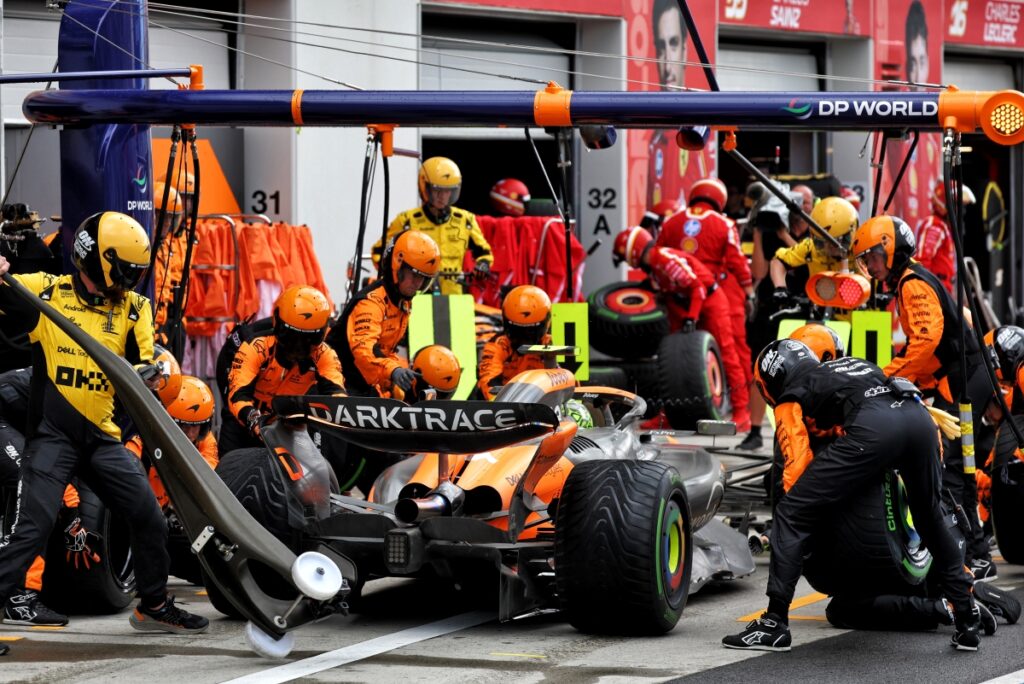How McLaren Botched a Near-Perfect Race Strategy: The Critical Decision That Cost Them the Canadian Grand Prix

It was a thrilling battle at the Canadian Grand Prix, and for a moment, it looked like McLaren's Lando Norris had a golden opportunity to snatch victory from the jaws of defeat. As Red Bull’s Christian Horner detailed, McLaren's strategic misstep during the race might have been the pivotal moment that handed victory back to Max Verstappen.
Norris, who showed impressive pace on the Intermediate tires by keeping them in better shape than his competitors, maneuvered his way past both Max Verstappen and the pole-sitter George Russell once the DRS was activated. In the early stages, it seemed like the stars had aligned for Norris and McLaren. Horner noted that Norris's ability to preserve his tires was vital to his gaining positions.
The Crucial Mistake
As the race unfolded and the track started to dry, McLaren decided to gamble on their strategy. They delayed Norris's switch to slick tires, hoping to capitalize on an overtaking opportunity while rivals were struggling to generate heat in their dry rubber. By the time Norris came in for the change, he had built a gap large enough to rejoin just ahead of Verstappen. However, upon exiting the pits, Norris struggled on the wet exit, and Verstappen swooped back into the lead.
Christian Horner argued that if McLaren had pitted Norris just one lap earlier, he would have had a much better shot at holding onto the lead. When Verstappen was tiptoeing on the Medium tires, McLaren's delayed call gave Verstappen an extra lap to heat up his tires, putting him in a better position to retake the lead. Horner took a strategic deep dive post-race, explaining how Red Bull timed their switch to the medium tires just right, enabling them to control the pace and maintain their lead.
 McLaren MCL38 makes a pit stop. 09.06.2024. Formula 1 World Championship, Rd 9, Canadian Grand Prix, Montreal, Canada, Race Day." />
McLaren MCL38 makes a pit stop. 09.06.2024. Formula 1 World Championship, Rd 9, Canadian Grand Prix, Montreal, Canada, Race Day." />What Could Have Been
Reflecting on the initial stages of the race, Horner conceded that McLaren appeared poised to dominate. Once the track started drying, Norris opened up a seven-second lead. McLaren looked set to capitalize, especially troubling George Russell and making gains once DRS was available. At that point, it seemed McLaren was in the driver's seat for a commanding victory.
Despite the drama and excitement, it all boiled down to one fateful decision. Horner emphasized how the Safety Car, which neutralized some of the action, and the subsequent pit stops, played right into Red Bull's hands. McLaren, who had looked set to execute an impeccable race, stumbled when it mattered most. The delay in tire change, combined with the challenges of generating immediate grip on slicks, turned out to be their undoing.
The Post-Race Analysis
Horner’s analysis post-race indicated that Red Bull's strategy was heavily focused on the conditions. They aimed to manage tire temperatures and pace as the track evolved. Norris capitalized well enough to hit the 20-second advantage mark initially, but with each lap, Verstappen’s tires got warmer, and McLaren’s window of opportunity narrowed. Horner was surprised McLaren didn’t cover Norris’s tires with an earlier pit stop after just one lap on the slicks.
Ultimately, Red Bull's superior timing and McLaren's slight strategic hiccup allowed Verstappen to pull ahead by a crucial gap. Racing is often about such fine margins, and this race was a prime example of how a single lap’s difference in tire strategy can make or break a win.
McLaren looked close to clinching what could have been a stunning triumph at the Canadian Grand Prix. However, Horner's insights show that precision in strategy is everything in the high-stakes world of Formula 1. McLaren and Norris will undoubtedly take this lesson to heart as they look to make future races less about 'what-ifs' and more about celebrating glad triumphs.